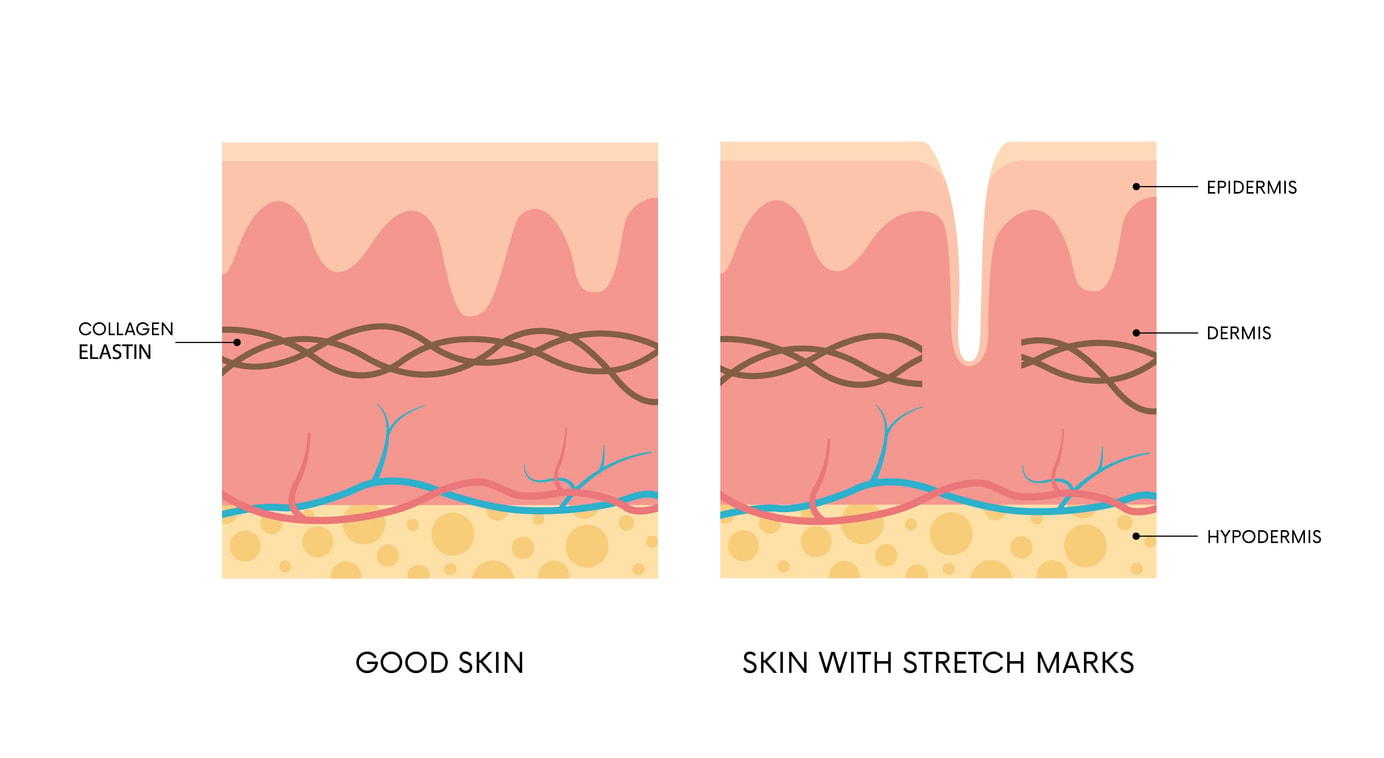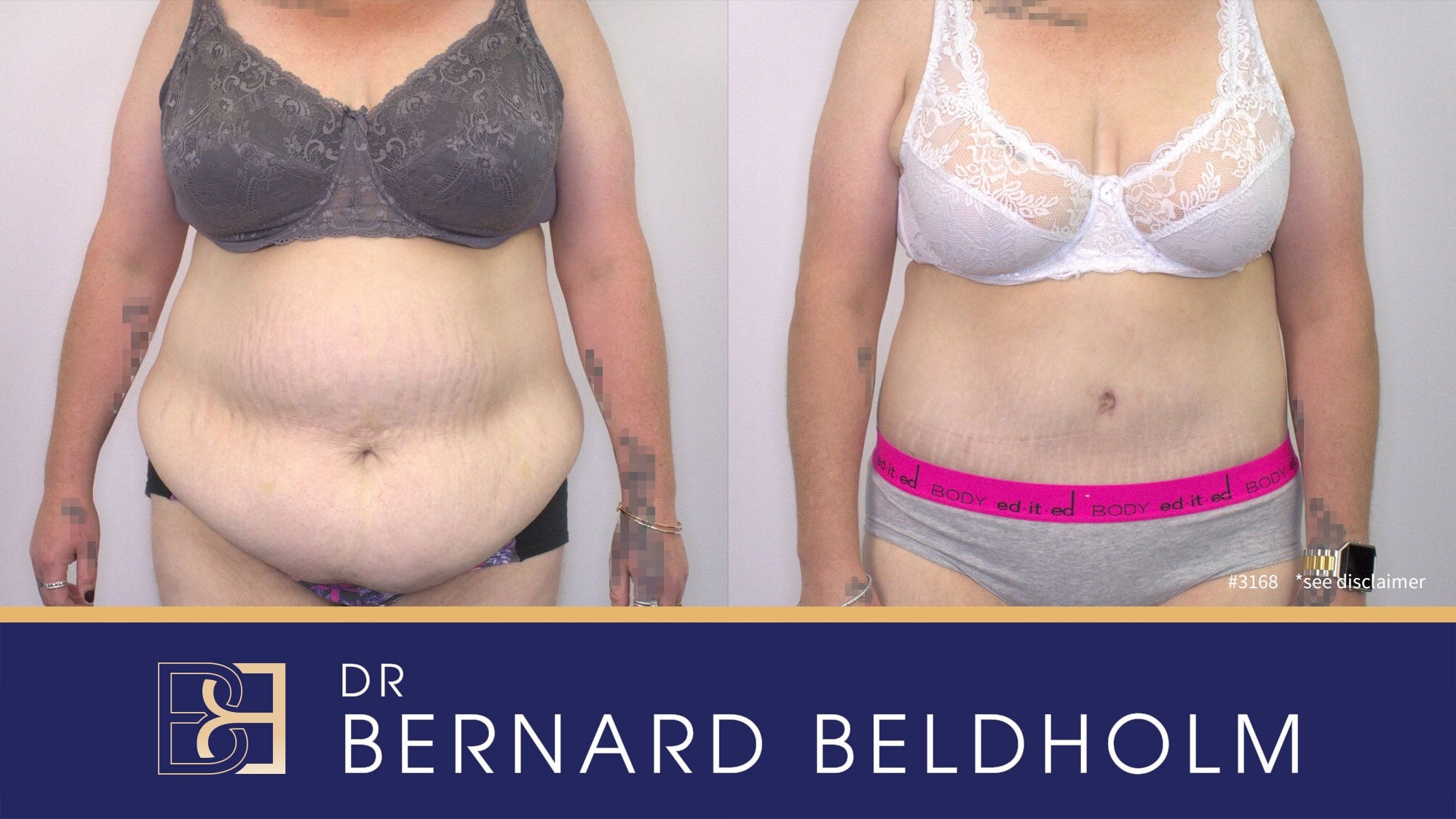Concerned about preventing stretch marks from pregnancy? While elimination isn’t guaranteed, there are proven ways to reduce them. Here you’ll find effective strategies to keep your skin smooth throughout your pregnancy.
Key Takeaways
- Stretch marks during pregnancy are caused by skin stretching due to weight gain and hormonal changes, affecting nearly half of expectant parents.
- To reduce stretch marks, stay hydrated, eat a balanced diet rich in essential vitamins, and use moisturisers regularly.
- Genetics significantly influence the likelihood of developing stretch marks, so if your family has them, you might too, regardless of your preventive efforts.
Understanding Pregnancy Stretch Marks
Book your appointment online now
Pregnancy stretch marks, also known as striae, are a common concern for many expectant parents. These streaky scars, which can appear red, pink, or even purple, occur when the skin stretches to accommodate a growing baby. But what exactly causes these marks, and what do they look like over time?
When you first notice stretch marks, they might be reddish or purplish streaks on your skin. This initial colouring is due to the increased blood vessels and inflammation in the area. As time goes by, these marks fade into white or silvery streaks, becoming less noticeable. Not all pregnant people will get stretch marks; genetics and individual skin types play a significant role.
Stretch marks develop because the skin stretches to make room for the baby, not just from weight gain. The stretching can cause the underlying layers of skin to tear slightly, leading to these visible marks. Around half of all pregnant women will develop stretch marks, though the severity and location can vary widely.
Stretch marks may also cause some itchiness when they first appear, a common sign that your skin is stretching. Despite their initial appearance, it’s reassuring to know that stretch marks typically fade after pregnancy and become much less noticeable over time.
Causes of Stretch Marks During Pregnancy

Skin stretching primarily causes stretch marks during pregnancy, with hormonal changes and genetics also playing a role in their development. Pregnancy weight gain is the main culprit. When weight increases, the skin stretches, which increases the likelihood of developing stretch marks, especially if the weight gain exceeds average amounts.
Hormonal changes also play a significant role. During pregnancy, your body produces hormones that relax collagen bonds, making your skin more susceptible to tearing. This explains why some people get stretch marks even with minimal weight gain.
Genetics also play a crucial role. If family members have had stretch marks, you’re more likely to develop them too. This genetic predisposition means that, despite your best efforts, you might still find yourself with a few stretch marks.
When and Where do Stretch Marks Appear?

Stretch marks typically start to appear during the second half of pregnancy, often making their debut in the second trimester. For many pregnant individuals, these early stretch marks become more noticeable around the beginning of the third trimester.
These marks can develop on various parts of the body, not just the abdomen.
Common areas include:
- Breasts
- Thighs
- Hips
- Buttocks
- Abdomen
The skin in these areas stretches significantly to accommodate the growing baby and the body’s changing shape, making them prime spots for stretch marks.
Among these locations, the stomach and breasts are the most common sites for pregnancy-related stretch marks. Knowing when and where stretch marks appear can help you proactively care for your skin and reduce their development.
Strategies to reduce Stretch Marks

Though you can’t completely prevent stretch marks, you can use several strategies to reduce their appearance. Staying hydrated, maintaining a healthy diet, and using moisturisers regularly promote healthy skin and reduce the risk of stretch marks.
Hydration keeps your skin soft and elastic, making it less prone to tearing. A balanced diet rich in vitamins and minerals supports skin wellness, while regular use of moisturisers can keep your skin hydrated and supple. Additionally, when properly cared for, skin heals more effectively.
Let’s explore these strategies in more detail.
Stay Hydrated
Staying hydrated is one of most effective ways to reduce stretch marks. Drinking plenty of water helps keep your skin soft and elastic, reducing the chances of developing stretch marks. Well-hydrated skin is more capable of stretching without tearing.
Incorporate hydration into your daily routine by drinking water throughout the day. Not only does this support overall wellness, but it also makes it less likely to develop stretch marks.
Keeping your skin hydrated from the inside out is key to preventing stretch marks.
Nutritious Diet
What you eat significantly impacts your skin ‘s fitness and can help reduce stretch marks. Consuming a balanced diet rich in vitamins and minerals can promote skin elasticity.
Foods high in:
- Vitamin A
- Vitamin C
- Vitamin E
- Zinc
- Omega-3 fatty acids
They are particularly beneficial.
Follow a nutritious and balanced diet to avoid gaining weight too quickly. Excessive weight gain can increase the risk of stretch marks, so it’s important to manage your weight gain. Eating a variety of nutrient-dense foods gives your skin the best chance to stretch without tearing.
Use Moisturisers Regularly
Using moisturisers regularly is another effective strategy to reduce marks. Keeping your skin moisturised helps maintain its elasticity, making it less prone to developing stretch marks. Products like cocoa butter and almond oil are known for their rich moisturising properties and can be particularly effective.
Applying moisturisers daily will yield the best results. By doing so, you can help nourish your skin and potentially reduce the appearance of stretch marks and rid of stretch marks.
Consistency is key, so make it a regular part of your self-care regimen.
The Role of Genetics in Stretch Marks

Genetics significantly impact the development of stretch marks. Research shows that both environmental factors and genetic predispositions contribute to this condition. If your family members have had stretch marks, you are more likely to develop them as well.
The elasticity of your skin, often influenced by genetics, is crucial in determining your likelihood of getting stretch marks. Those with lower skin elasticity are more prone to developing these marks.
This is why not every individual will experience stretch marks during pregnancy, despite similar preventative measures.
Post-Pregnancy Stretch Mark Treatments
After pregnancy, you might be looking for ways to treat existing stretch marks. Fortunately, there are several effective treatments available. These treatments range from topical creams to professional procedures, each offering different levels of effectiveness.
Stretch marks typically fade over time, taking about 6 to 12 months to become less noticeable. Certain treatments can speed up this process and reduce the appearance of mature stretch marks. Stretch marks fade with appropriate care.
Topical Treatments
Topical treatments are popular for treating stretch marks. Ingredients like hyaluronic acid and retinoids can help boost collagen production and increase skin elasticity. These products can be applied directly to affected areas to help treat stretch marks and reduce the appearance of stretch marks.
Using creams and lotions with these beneficial ingredients in your skincare routine can proactively manage and reduce stretch marks to prevent pregnancy stretch marks during and after pregnancy. Additionally, incorporating stretch mark creams can maximise your efforts.
Professional Procedures
For more advanced treatment, professional procedures like laser therapy and microneedling can be effective. Laser therapy stimulates collagen production, making it a popular treatment choice.
Microneedling, involving tiny skin punctures to stimulate collagen growth, can also help reduce the appearance of stretch marks. These procedures can significantly target skin texture and reduce the visibility of stretch marks, though multiple sessions may be needed for noticeable results.
Myths About Preventing Stretch Marks
Many myths surround the prevention of stretch marks. A common misconception is that using oils and creams guarantees you won’t get stretch marks. While these products can help, they don’t offer a surefire solution, as genetics play a significant role.
Another myth is that if you get stretch marks during one pregnancy, you can completely avoid them in future pregnancies. The reality is that individual skin elasticity varies, and while you can take steps to reduce stretch marks, you can’t guarantee their prevention.
Abdominoplasty Surgery for Stretch Marks
Abdominoplasty is a surgical procedure that can target stretch marks, particularly those located on the lower abdomen. This surgery involves removing excess skin and fat from the abdominal area and tightening the underlying muscles, resulting in a smoother and firmer appearance.
During an abdominoplasty, the surgeon makes an incision along the lower abdomen, typically from hip to hip. The skin is then lifted, and any excess skin and fat are removed. If stretch marks are present on the excised skin, they are eliminated as well. The remaining skin is then pulled down and sutured into place, creating a tighter and more toned look.

Tattoo blurred for privacy
Disclaimer: Operation performed by Dr Bernard Beldholm. Adult content, surgery has risks; individual results vary, seek 2nd opinion. Please see the full disclaimer.
It’s important to note that while abdominoplasty can significantly reduce the appearance of stretch marks below the navel, it may not affect those above it. Additionally, the procedure is usually recommended for individuals who have completed their family planning, as future pregnancies can affect the results.
If you’re considering abdominoplasty for stretch marks, it’s essential to consult with a qualified specialist surgeon to discuss your goals, expectations, and any potential risks associated with the procedure.
Dr. Beldholm’s Final Conclusion

While stretch marks are a common part of pregnancy, there are several strategies you can employ to reduce their appearance. Staying hydrated, maintaining a healthy diet, and using moisturisers regularly can reduce the risk of stretch marks. It’s important to remember that genetics also play a significant role, and some factors are beyond your control.
As a specialist surgeon, I encourage you to focus on self-care and embrace the changes your body goes through during pregnancy. With the right approach, you can help your skin stay resilient, making stretch marks less of a concern. Remember, your body is doing something truly remarkable, and taking care of your skin is just one part of the journey.
Frequently Asked Questions
Can stretch marks be completely prevented during pregnancy?
You can’t completely prevent stretch marks during pregnancy, but you can reduce the risk by keeping your skin moisturised and staying hydrated. Genetics and skin type play a big role, so just do your best!
What are the best moisturisers to use for preventing stretch marks?
To prevent stretch marks, go for moisturisers with cocoa butter, almond oil, or hyaluronic acid.
How long do stretch marks take to fade after pregnancy?
Stretch marks usually take around 6 to 12 months to fade and become less noticeable after pregnancy. Patience is key, and they’ll gradually soften over time.
Are professional treatments effective for stretch marks?
Absolutely! Treatments like laser therapy and microneedling can really make a difference in how stretch marks look. But just keep in mind that you might need a few sessions for the best results.
Do genetics play a role in the development of stretch marks?
Absolutely, genetics definitely play a role in stretch marks, affecting your skin’s elasticity and how prone you are to getting them. So if someone in your family has them, you might be more likely to get them too.
Book your appointment online now
References
- Bylka, Wieslawa, et al. “Centella Asiatica in Cosmetology.” Postepy Dermatology, vol. 30, no. 1, Feb. 2013, pp. 46–49.
- Devillers, C., et al. “High Resolution Skin Colorimetry, Strain Mapping and Mechanobiology.” International Journal of Cosmetic Science, vol. 32, no. 4, 2010, pp. 241–245., doi:10.1111/j.1468-2494.2009.00562.x.
- Dhital, Basant, et al. “Ultraviolet Radiation Reduces Desmosine Cross-Links in Elastin.” Biochemistry and Biophysics Reports, vol. 10, 2017, pp. 172–177., doi:10.1016/j.bbrep.2017.04.002.
- Gilmore, SJ, et al. “A Mechano‐Chemical Model for Striae Distensae.” Math Biosci, vol. 240, 2012, pp. 141–147., doi:10.1007/springerreference_42626.
- Huizen, Jennifer. “Stretch Marks on Breasts: Types, Treatment Options, and Risk Factors.” Medical News Today, MediLexicon International, www.medicalnewstoday.com/articles/319800.php.
- Kang, S, et al. “Topical Tretinoin (Retinoic Acid) Improves Early Stretch Marks.” Arch Dermatol, vol. 101, no. 1, 1 May 1996, p. 256., doi:10.1097/00006534-199801000-00083.
- Manjula Jegasothy, S, et al. “Efficacy of a New Topical Nano-Hyaluronic Acid in Humans.” The Journal of Clinical and Aesthetic Dermatology, vol. 7, no. 3, Mar. 2014, pp. 27–29.
- Moldovan, Mirela Liliana, et al. “Preliminary Study on the Development of an Antistretch Marks Water-in-Oil Cream: Ultrasound Assessment, Texture Analysis, and Sensory Analysis.” Clinical, Cosmetic and Investigational Dermatology, Volume 9, 2016, pp. 249–255., doi:10.2147/ccid.s107298.
- “Stretch Marks: Why They Appear and How to Get Rid of Them.” Stretch Marks: Why They Appear and How to Get Rid of Them | American Academy of Dermatology, AAD, www.aad.org/public/skin-hair-nails/skin-care/stretch-marks.
- Ud-Din, S., et al. “Topical Management of Striae Distensae (Stretch Marks): Prevention and Therapy of Striae Rubrae and Albae.” Journal of the European Academy of Dermatology and Venereology, vol. 30, no. 2, 2015, pp. 211–222., doi:10.1111/jdv.13223.


